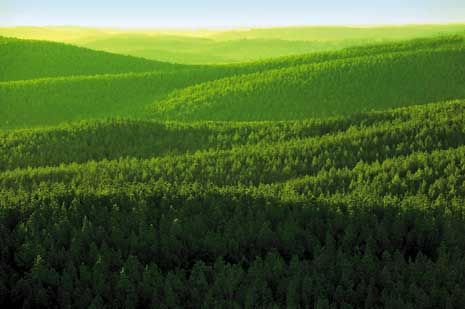In the ongoing debate over whether the U.S. forest resource will be ample enough to sustain the long-term needs of both established markets and the emerging wood bioenergy sector, some perspective—global, historical and otherwise—is appropriate.

Timberland is the established core operation of Deltic Timber Corp., a regional forest products entity with a major diversification in real estate development. The El Dorado, Ark. company owns two sawmills, a 50% interest in a medium density fiberboard plant (all in Arkansas) and 438,600 acres of timberland—primarily southern pine—in Arkansas and Louisiana. Deltic considers timberland its most valuable asset and the harvest of stumpage to be its most significant source of income. Starting a timberland acquisition program in 1996, Deltic sells non-strategic properties while growing its land base and volume of growing stock. (Photo courtesy Deltic Timber Corp.)
In its Global Forest Resource Assessment of 2005 (the latest year officially documented), the United Nations’ Food and Agriculture Organization (FAO) ranked the U.S. fourth worldwide in “forested area” at just under 750 million acres. With 766 million, Canada edged the U.S. for third place. Brazil came in second with 1,181,138 and the Russian Federation was on top with 1,999,039. Worldwide, total forested area was estimated at 9.75 billion acres.
The U.S. Forest Service (USFS) classifies some 504 million acres (including national forests but excluding national parks) of this forested area as commercial timberland—that suitable for growing repeated tree crops. About 72% of this acreage is located in the eastern half of the country. Of the 504 million, 19% is owned by the Forest Service and another 10% is owned by other federal, state and local government entities. As of 2000, the USFS designated some 67 million acres as owned by forest industry companies. However, this total today is down by at least 21 million acres, according to Timber Mart-South, a University of Georgia timber market newsletter that also monitors major timberland transactions. These 21 million acres, for the most part, now belong to institutional and/or private investors.
FAO included the U.S. as having one of the most sustainable forest bases of all nations. Along with Russia, Canada and Australia, the U.S. forest base held steady from 1990-2005. Brazil, on the other hand, saw its forest base diminish by 8% while China’s increased 20%. According to FAO statistics, China leads the world in forest plantation acreage with 78 million. In second place, the U.S. has about 42 million. Even though its forest acreage is far smaller than Russia’s, Brazil edges Russia in growing stock volume while the U.S. clips Canada for third place.
Still Formidable
Despite the current economic carnage, the forest industry remains an important component of rural economies in the U.S., which is the world’s largest producer, consumer and importer of wood products, according to the USFS. It’s also the second largest exporter of wood products behind Canada.
Except for modest dips caused by economic recessions, the U.S. roundwood timber harvest remained consistent from the late ’70s through 2006, according to USFS documents, but it has shifted more to the Southern states since Western national forest timber sales began to contract in the early ’90s. At 17.2 billion cu. ft., the U.S. timber harvest in 2005 (most recent year officially documented) was the largest since 2000. USFS figures indicated the harvest peaked in 1991 at 18.8 million cu. ft. The agency estimated that 52% of the ’05 roundwood harvest was used for the manufacture of domestic lumber and engineered wood products, including plywood and oriented strandboard (OSB). The second largest amount, 37%, was consumed by pulp and paper mills and included both roundwood and chips. The rest went toward miscellaneous uses. A relatively small volume of both chips and logs was exported. The USFS research paper cited herein, FPL-RP-637, did not track the volume of chips or other wood biomass originating on commercial timberland.
For the record, in 2005 the nation’s national forests accounted for only 1.3 billion bd. ft., less than 2% of the total roundwood harvest, down 75% from the peak in 1991.
Southern Clout
If the forest products industry is an important rural economic train, then the South is the engine. The U.S. harvest is concentrated in the region, which accounts for 60% of it year-to-year. Excluding Forest Service holdings, Southern commercial timberland amounts to approximately 214 million acres and is overwhelmingly privately owned. The South claims a majority of the nation’s forest plantations, its most intensely managed and most productive tree farms. Long the U.S. leader in pulp and paper manufacturing, the South also has led the nation in total lumber output since 1990 and for some 15 years has dominated in plywood and OSB output.
Using the mid to late 1990s as a benchmark, the USFS indicates the nation’s lumber capacity has held steady, even though mill numbers have faded. Conversely, plywood capacity has declined steadily since 1983, yet the capacity of OSB, which has replaced plywood in many applications, rose significantly in the last decade.